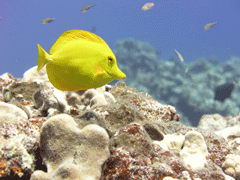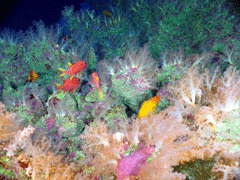Monumental Marine Move
Air Date: Week of January 9, 2009

Yellow Tang near Maug Island in the Mariana Archipelago. (Photo: Robert Schroeder, Courtesy of NOAA, Pacific Islands Fisheries Science Center, Coral Reef Ecosystem Division)
With two weeks left in office, President Bush has set aside an area in the Pacific Ocean the size of Texas for conservation. Three separate marine monuments have been created, one of which includes the Marianas Trench, the deepest part of the earth’s surface. Host Steve Curwood gets the update on the blue Bush legacy from Josh Reichert, managing director of the Pew Environment Group which spearheaded efforts to create the Marianas sanctuaries.
Transcript
CURWOOD: It's Living on Earth, I'm Steve Curwood.
President George W. Bush leaves office with a controversial green legacy—but some say he’s built an impressive blue one. First, a huge marine protected reserve north of Hawaii. And now three more Pacific Marine Monuments that include the Marianas Trench, the deepest spot on earth.
BUSH: We have pioneered a new model of cooperative conservation in which government and private citizens and environmental advocates work together to achieve common goals. And while there's a lot more work to be done, we have done our part to leave behind a cleaner, and healthier and better world for those who follow us on this Earth.
CURWOOD: The Pew Environment Group spearheaded the effort to give these reserves the legal status of national parks. Joshua Reichert is the Pew group’s managing director. And Josh, the president gets a lot of criticism on the environment, so what do you make of this blue legacy?

Soft corals and tropical fish share a paradise of habitat on the summit of an underwater volcano in near the Northern Mariana Islands. (Courtesy of the NOAA Submarine Ring of Fire 2004 Exploration and the NOAA Vents Program)
CURWOOD: Now President Bush has a reputation of not being that friendly with environmental concerns. What do you think makes the difference with him when it comes to marine issues?
REICHERT: Well, I think that both he and his wife, Laura Bush, for reasons that are a little bit unknown, have a particular affinity for the ocean environment. There was also strong interested on the part of Jim Connaughton who is the chairman of the Council on Environmental Quality in the White House, who in many respects led a rather long and sometimes lonely battle within the administration to get this done. And he really deserves a lot of credit.
CURWOOD: Tell me why these areas are so important in ecological, geological and biological terms, Josh.

Brown Booby and nest on Maug Island. Seabird populations in the Northern Mariana Islands support regionally important seabird colonies. (Photo: Russell Moffitt, Courtesy of NOAA, Pacific Islands Fisheries Science Center, Coral Reef Ecosystem Division)
CURWOOD: Looking ahead now, the Bush administration is creating this monument, but in fact the Obama administration is really going to have to do the work – I would say on the ground, except in this case, I guess, you know, in the ocean, to get all this done. And the woman who’s going to be running the National Oceanic and Atmospheric Administration has had a close relationship with your organization. How well do you think that Jane Lubchenco and the Obama administration will be able to put this monument into action?

Yellow Tang near Maug Island in the Mariana Archipelago. Photo: Robert Schroeder, Courtesy of NOAA, Pacific Islands Fisheries Science Center, Coral Reef Ecosystem Division)
CURWOOD: How optimistic are you that the Obama administration will do what you think is necessary for this?
REICHERT: I think the jury is out on that. I don’t have any doubt that the people who are going to be coming into this administration are going to want to make this happen. There are fiscal constraints that the Obama people are going to have to be living with that are going to make a lot of things much more difficult to do than they would have been some years ago. So we’ll just have to see. Obviously we will try very hard to make sure that the next administration frees up the resources that are needed in order to make these monuments work.
CURWOOD: Josh Reichert is managing director of the Pew Environment Group. Thank you so much, sir.
REICHERT: Thank you, Steve
[Bombay Dub Orchestra “Greenish Blue” from 3 Cities (Six Degrees Records 2008)]
Links
Pew Environment Group's work in the Northern Mariana Islands
Living on Earth wants to hear from you!
Living on Earth
62 Calef Highway, Suite 212
Lee, NH 03861
Telephone: 617-287-4121
E-mail: comments@loe.org
Newsletter [Click here]
Donate to Living on Earth!
Living on Earth is an independent media program and relies entirely on contributions from listeners and institutions supporting public service. Please donate now to preserve an independent environmental voice.
NewsletterLiving on Earth offers a weekly delivery of the show's rundown to your mailbox. Sign up for our newsletter today!
 Sailors For The Sea: Be the change you want to sea.
Sailors For The Sea: Be the change you want to sea.
 The Grantham Foundation for the Protection of the Environment: Committed to protecting and improving the health of the global environment.
The Grantham Foundation for the Protection of the Environment: Committed to protecting and improving the health of the global environment.
 Contribute to Living on Earth and receive, as our gift to you, an archival print of one of Mark Seth Lender's extraordinary wildlife photographs. Follow the link to see Mark's current collection of photographs.
Contribute to Living on Earth and receive, as our gift to you, an archival print of one of Mark Seth Lender's extraordinary wildlife photographs. Follow the link to see Mark's current collection of photographs.
 Buy a signed copy of Mark Seth Lender's book Smeagull the Seagull & support Living on Earth
Buy a signed copy of Mark Seth Lender's book Smeagull the Seagull & support Living on Earth

